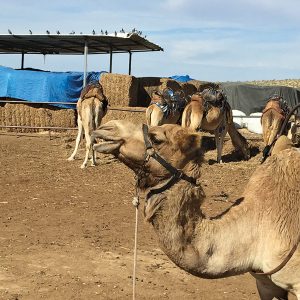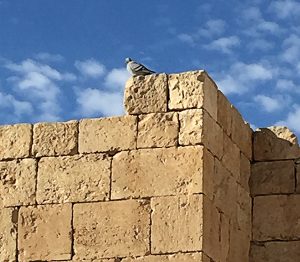Editor’s Note: In 2016, we’re taking a look at how to convert do-it-yourself (DIY) practitioners to customers of professional pest management services — and how to prevent current customers from going “the other way.” In this second installment, we examine the importance of finding potential customers everywhere you look, even when on vacation. If you’ve got a topic idea you want to suggest (or even write about), email us at PMPEditor@northcoastmedia.net.

Notice the pigeons on the roof of the camel feed station in Israel.
Photos: ©Stuart Aust
Sometimes business opportunities present themselves in unexpected places. So the next time you’re on vacation, visiting a point of interest that attracts as many pigeons as it does tourists, consider presenting a bird management proposal to those in charge.
I do a fair amount of traveling around the world and everywhere I go, I see pigeons roosting on ancient and modern historical buildings, museums and palaces. In fact, my wife, Donna, and I recently returned from touring Jerusalem and Israel, and I was amazed at the pigeon infestation and droppings at key historical landmarks and archeological sites.
The acid in pigeon feces is responsible for staining and permanently damaging the surfaces on these historical buildings in particular. Historical sites built with soft stones such as limestone or sandstone are highly absorbent, and therefore absorb the feces more readily — causing stain and corrosion if they are not removed quickly. Sometimes the staining from excrement is irreversible, even after thorough cleaning.
Handle with care
If you are awarded a bird management contract, use extreme caution when using cleaning products on these types of surfaces. We always recommend cleaning a small area first to ensure there is no staining from the products themselves.
When an architectural firm contracted us to power wash and clean the exterior façade of an historical embassy in New York City, we first tested a small area. This ensured the cleaning agent caused no staining before proceeding with power washing the rest of the building.
When the United Nations is in session each September, there can be 10 to 15 leaders of countries and other dignitaries at the embassy that we service. We play a key role in upholding the aesthetic and integrity of this building. No one wants to look at pigeon guano when visiting a historical site. Offering cleaning and sanitizing services is a much needed and valuable service.
Many effective deterrents

A pigeon sits on a tower in the Jewish city of Arad, Solomon’s fortress located in the
Negev Desert.
Photo: ©Stuart Aust
After cleaning, the next course of action is installing a bird deterrent that effectively keeps the pigeons off the buildings. Because these locations are historic, the deterrents of choice are usually low-profile products that are aesthetically pleasing or invisible to the eye. Today, there are a plethora of products offered, giving our clients numerous choices. Some clients know exactly what deterrents they want installed. Others look to us for our professional recommendations.
We tend to give our clients options; however, the clients’ specific needs and the severity of the problem might determine what deterrents to install. There are many ways to skin a cat when it comes to bird control, and many of the deterrents can accomplish similar results.
The next time you step back in time, marveling at ancient civilizations, historic buildings or palatial monuments, be sure to note the pigeons first and the nostalgia second: The first one can pay for your next travel adventure.
Talking points for prospective customers
Birds not only obstruct the view, they also cause damage to historic structures. When creating a bird control proposal for prospective clients, it may help to mention these facts:
- It’s estimated there are more than 400 million pigeons (Columbidae) worldwide.
- Pigeons can harbor up to 60 known diseases, including histoplasmosis, cryptococcosis and candidiasis. Seven of these diseases can be transmitted to humans.
- Pigeon nesting can lead to parasites, including ticks and mites, in structures.
- Pigeon droppings create a foul odor.
- Pigeons mate for life and breed all year round, although March through July is peak season.
- The average life span of a pigeon in the wild is between three and five years. Some pigeons have lived up to 30 years, however.
- Pigeons are indigenous to the Middle East. The first images of pigeons were found by archaeologists in Mesopotamia (current Iraq) dating back to 3000 BCE.
Leave A Comment